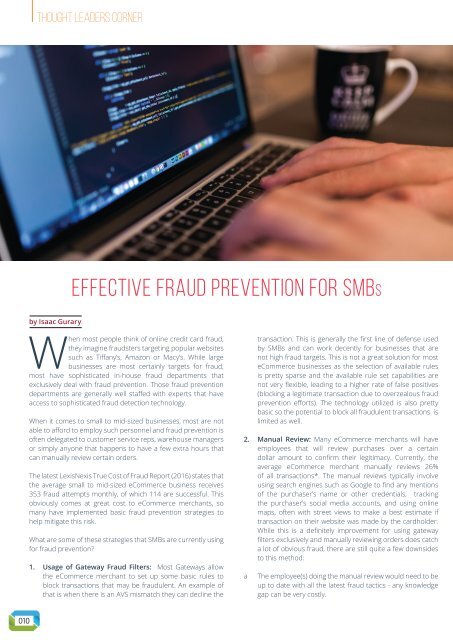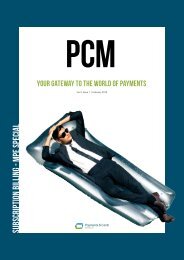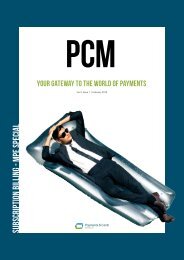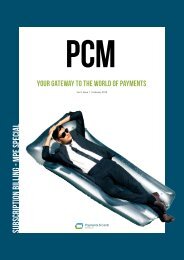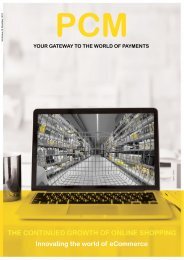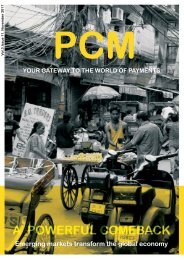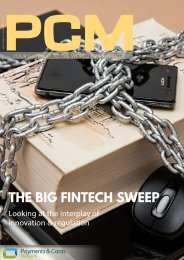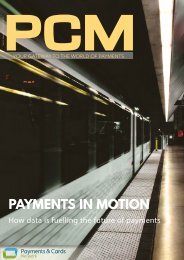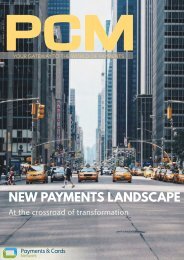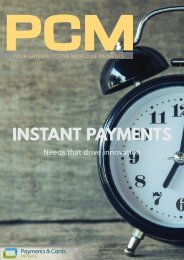Money2020_2016_special
Create successful ePaper yourself
Turn your PDF publications into a flip-book with our unique Google optimized e-Paper software.
Thought Leaders Corner<br />
Effective Fraud Prevention for SMBs<br />
by Isaac Gurary<br />
When most people think of online credit card fraud,<br />
they imagine fraudsters targeting popular websites<br />
such as Tiffany’s, Amazon or Macy’s. While large<br />
businesses are most certainly targets for fraud,<br />
most have sophisticated in-house fraud departments that<br />
exclusively deal with fraud prevention. Those fraud prevention<br />
departments are generally well staffed with experts that have<br />
access to sophisticated fraud detection technology.<br />
When it comes to small to mid-sized businesses, most are not<br />
able to afford to employ such personnel and fraud prevention is<br />
often delegated to customer service reps, warehouse managers<br />
or simply anyone that happens to have a few extra hours that<br />
can manually review certain orders.<br />
The latest LexisNexis True Cost of Fraud Report (<strong>2016</strong>) states that<br />
the average small to mid-sized eCommerce business receives<br />
353 fraud attempts monthly, of which 114 are successful. This<br />
obviously comes at great cost to eCommerce merchants, so<br />
many have implemented basic fraud prevention strategies to<br />
help mitigate this risk.<br />
What are some of these strategies that SMBs are currently using<br />
for fraud prevention?<br />
1. Usage of Gateway Fraud Filters: Most Gateways allow<br />
the eCommerce merchant to set up some basic rules to<br />
block transactions that may be fraudulent. An example of<br />
that is when there is an AVS mismatch they can decline the<br />
transaction. This is generally the first line of defense used<br />
by SMBs and can work decently for businesses that are<br />
not high fraud targets. This is not a great solution for most<br />
eCommerce businesses as the selection of available rules<br />
is pretty sparse and the available rule set capabilities are<br />
not very flexible, leading to a higher rate of false positives<br />
(blocking a legitimate transaction due to overzealous fraud<br />
prevention efforts). The technology utilized is also pretty<br />
basic so the potential to block all fraudulent transactions is<br />
limited as well.<br />
2. Manual Review: Many eCommerce merchants will have<br />
employees that will review purchases over a certain<br />
dollar amount to confirm their legitimacy. Currently, the<br />
average eCommerce merchant manually reviews 26%<br />
of all transactions*. The manual reviews typically involve<br />
using search engines such as Google to find any mentions<br />
of the purchaser’s name or other credentials, tracking<br />
the purchaser’s social media accounts, and using online<br />
maps, often with street views to make a best estimate if<br />
transaction on their website was made by the cardholder.<br />
While this is a definitely improvement for using gateway<br />
filters exclusively and manually reviewing orders does catch<br />
a lot of obvious fraud, there are still quite a few downsides<br />
to this method:<br />
a<br />
The employee(s) doing the manual review would need to be<br />
up to date with all the latest fraud tactics - any knowledge<br />
gap can be very costly.


